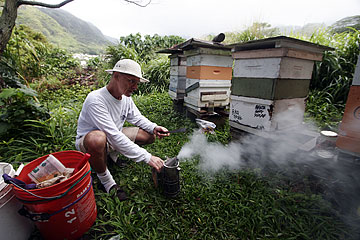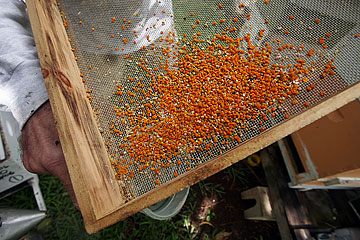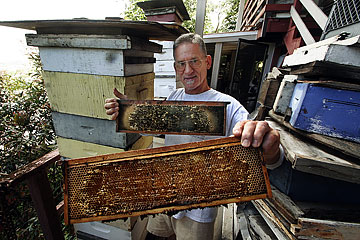
DENNIS ODA / DODA@STARBULLETIN.COM
Beekeeper Michael Kliks, owner of Manoa Honey Co., starts to smoke the area and entrance to one of his beehives. The bees interpret the smoke as a danger so they stay inside their hives seeking shelter. He is attaching a pollen-collecting chamber to the entrance. CLICK FOR LARGE
|
|
To bee or not to bee?
Hawaii's honey is still pure, but output is down due to an erratic environment and foreign imports
Wearing shorts and a long-sleeved T-shirt, beekeeper Michael Kliks pulls out a honeycomb from the wood box to inspect the work of his bees.
Everything looks fine today to Kliks, owner of Manoa Honey Co., as he observes the brood that the busy queen bee planted in the waxcomb. It's something he monitors closely, given the ongoing crisis that has hit the rest of the world.
Bees are reportedly vanishing, in 22 states across the nation, stricken by mites, pathogens and the most recent outbreak of "fall dwindle disease."
Hawaii remains one of the few places in the world where the bees, because of the geographic isolation and quarantine, remain healthy.
Yet beekeepers in Hawaii are still wary. While the bee population has been steady, production of honey in Hawaii was down 21 percent last year, compared to 2005, according to the latest data from the National Agricultural Statistics Service. Nationally, honey production was down 11 percent last year from 2005.
Something about the environment is out of whack, according to Kliks, a beekeeper, or apiarist, of 27 years.
Kliks has about 100 colonies at 12 different sites on Oahu -- from Nanakuli to Kalaeloa.
"We watch our bees just like you'd watch your cows, sheep or goats," he said. "We knew 10 years ago something was going on. We haven't had a decent harvest here for at least a decade."
Mangoes and avocados are blooming out of season, he said, as are the kiawe trees -- all of which the bees feed on. "Everything is helter skelter and our bees are starving," he said.
Cheap imports
Honey producers here cite another growing threat -- huge imports of foreign honey.
Oftentimes, these imports, mostly from China and Argentina, offer several mixes of honey that are further diluted by large distributors with high fructose corn syrup. They are then repackaged and sold on store shelves for less than the wholesale price.
Yet they are labeled as a "Product of the U.S.A." or "100 percent U.S. Grade A" honey.
Kliks, also president of the Hawaii Beekeepers Association, is pushing for the passage of a bill that would keep these mislabeled honeys out of Hawaii.
The Senate Bill would require stricter labeling standards from companies, including the specific percentage of honey from each country of origin and the amount of other sweeteners added, including ultrafiltered sweeteners.
The bill also seeks to prohibit the use of "Hawaii honey" or "Hawaiian honey" in ads or labels, unless it is produced entirely in the state.
Opponents of the bill say it is asking for stricter standards than already required by existing federal laws.
But Kliks says the bill is necessary to protect honey producers in Hawaii who maintain their standards and quality.

DENNIS ODA / DODA@STARBULLETIN.COM
Beekeeper Michael Kliks shows pollen that he's collected from one of his bee hives in Manoa. He says the collecting bin is at the entrance to the hive and he estimates about 80 percent of the pollen is collected from the legs of the bees. The rest of the pollen is eaten. If the bee hive is not doing well, he takes off the pollen-collecting bin. CLICK FOR LARGE
|
|
"There is honey out there that is adulterated, contaminated and diluted with other sugars, then labeled as U.S. honey," he said. "They are, in fact, stealing from us when they do this."
Testing is key, according to Kliks, who wants to set up a lab to monitor the adulterated honeys.
"We have the purest and cleanest honey in the world, and we monitor them very carefully," Kliks said.
"The promise I want from the state is to enforce these by being the bulldog on the porch."
The market here is small compared to the rest of the world, given that Hawaii only produces 4.7 percent of what California produces overall. The Golden State produced close to 20 million pounds of honey last year, to Hawaii's 930,000 pounds.
But Hawaii's honey producers have a competitive advantage: The geographic isolation and ability to market quality honeys from a paradise state for a higher price. They also can produce honey year-round because of the warm climate.
A stinging business
Kliks and the other apiarists in the state, about 30 of them in all, say it's getting harder to keep up their livelihoods.
Garnett Puett, a fourth-generation beekeeper, beeswax artist and owner of Captain Cook Honey Co. on the Big Island, says honey production in Hawaii has its share of challenges.
Among them are access to land, finding enough labor, and the limitations of living on an island where the bees have been quarantined since the mid-1980s. Building a bee business takes years of patience and investments, according to Puett, one of the state's leading honey producers.
"We lose locations every year because of developments," he said.
However, he does it because he loves it.
"It's in my blood," he said. "I had my first hive when I was 5 years old."
Today, he oversees about 125 sites and 3,600 colonies on the Big Island, some of which are on borrowed farmlands. He does pretty well, producing more than half a million pounds of honey per year.
For the last nine years, he's been offering a line of certified organic honey made from nectar of the Ohia Lehua Blossom, Christmas Berry and Macadamia Nut Blossom.
Still, Puett is constantly aware his way of life is vulnerable to changes in the environment. If the Africanized honey bee or varroa mite were to somehow get into Hawaii, he said, "it would wipe out my business."
Puett worries just as much about genetically modified crops, which he says threaten his population of bees if they should end up pollinating and producing honey from those crops.

DENNIS ODA / DODA@STARBULLETIN.COM
Beekeeper Michael Kliks, owner of Manoa Honey Co., shows some of his extracted cones from beehives that are located at his home in Manoa. Extracted cones have the caps of the honey combs cut off and the honey centrifuged out of them. These will be reused in the beehives where the bees will clean them out and fill them up with more honey. On the right are spare parts that he may reuse to maintain his hives. CLICK FOR LARGE
|
|
Personally, Kliks said he produced less than 4,000 pounds of honey this year, half what he used to make. During the peak of the honey business in the late 1980s, he produced 20,000 pounds.
He sells the honey, branded as Pele's Gold and Crater Kiawe, to more than 30 stores, including Down to Earth, Shirokiya and Executive Chef.
Puett says his honey production is 30 to 40 percent down from what he remembers 20 years ago.
Though they don't know what's going on, beekeepers say climate changes may be responsible for some of the lower production.
Kliks, 65, says the trade itself is dying, as beekeepers on the mainland lose interest in their trade, while overall morale is low. Personally, he hasn't found anyone who wants to carry on his business.
"It's a human loss of faith," said Kliks. "There are beekeepers that have lost hope and stopped replacing their assets. They've given up."
Though he gets stung by the bees about 10 times per day, on average, Kliks keeps going because he believes "it's a rightful livelihood."
Besides making honey, bees also produce wax and perform the important function of pollinating crops -- from almonds to macadamia nuts, apples, oranges, melons, blueberries and cherries.
"They do good," said Puett. "Bees don't do anything but good."

